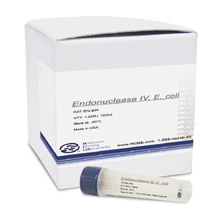-
DNA Repair Proteins, Enzymes
Endonuclease III (Nth)
Endonuclease III (Nth) protein from E. coli acts as both N-glycosylase and a AP-lyase. The N-glycosylase activity releases damaged pyrimidines from double-stranded DNA, generating a basic (AP site).
-
DNA Repair Proteins, Enzymes
Endonuclease IV, E. coli
A class II apurinic/apyrimidic (AP) enzyme that cleaves 5’ to an AP site by hydrolysis leaving a hydroxyl group at the 3´ terminus and a deoxyribose 5´-phosphate at the 5´…
-
DNA Repair Proteins, Enzymes
Endonuclease V, E. coli
Endonuclease V, (Endo V) is a 3′-endonuclease involved in DNA repair, which initiates removal of deaminated bases from damaged DNA, including uracil, hypoxanthine, and xanthine.
-
DNA Repair Proteins, Enzymes
Endonuclease VIII, E. coli
Endonuclease VIII from E. coli acts as both an N-glycosylase and an AP-lyase. The N-glycosylase activity releases damaged pyrimidines from double-stranded DNA, generating an apurinic (AP site).
-
DNA Repair Proteins, Enzymes
Human Alkyl Adenine DNA Glycosylase
Human Recombinant produced in E.Coli is a single, non-glycosylated polypeptide chain containing 306 amino acids (1-298 a.a.) and having a molecular mass of 33.9kDa (Molecular weight on SDS-PAGE will appear…
-
DNA Repair Proteins, Enzymes
MutS Protein (Thermus aquaticus)
The MutS DNA mismatch protein recognizes heteroduplex DNAs containing mispaired or unpaired bases.
-
DNA Repair Proteins, Enzymes
Uracil DNA Glycosylase (UDG)
Uracil-DNA Glycosylase catalyzes the hydrolysis of the N-glycosylic bond between the uracil and sugar, leaving an abasic site in uracil-containing single or double-stranded DNA. The enzyme shows no measurable activity…

